Originally posted in The Daily Star on 20 February 2024
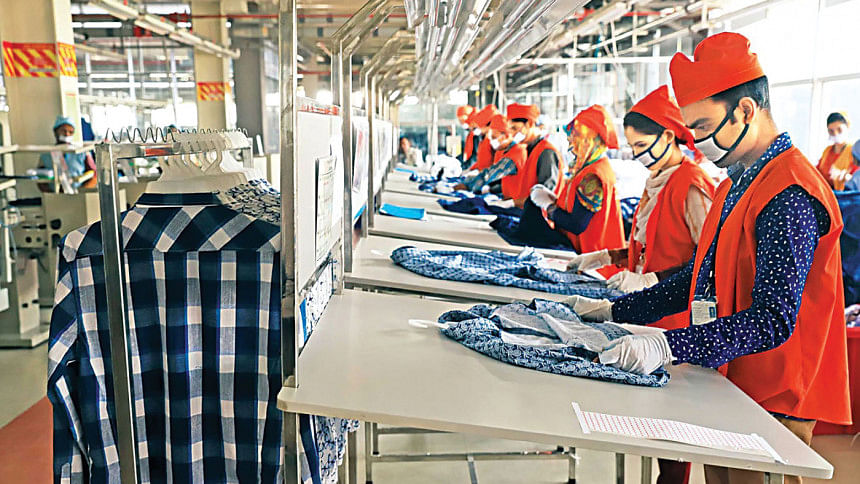
The highly impressive track record of Bangladesh’s export-oriented readymade garments (e-o RMG) sector is well-known and well-appreciated. However, in recent times, the growing predominance of RMG in the country’s export basket and its overwhelming share in the country’s total export earnings have given rise to considerable concerns in Bangladesh’s policy circles. And rightly so. RMG’s share in the country’s earnings from global exports currently stands at about 84 percent, with the share having registered a secular rise over the past several years. True, this overriding dependence on a single export product could potentially be fraught with danger. Any significant reversal in RMG’s export fortune or market volatility could put the country at significant risks. This could consequently have implications for forex reserves, import capacity, debt repayment sustainability, employment generation and the overall growth of the country’s manufacturing sector and GDP. There is thus no denying that diversification of exports, beyond the e-o RMG sector, was crucially important for the Bangladesh economy, and consequently this needs to be pursued in all earnest.
However, what is argued in this write-up is that, in emphasising the need for export diversification, away from and beyond the RMG, one should not ignore the opportunities that lie, and significant benefits that could potentially be reaped from, export diversification within the RMG sector. Thus, this particular aspect of the country’s export and development strategy deserves equal, and no less attention, on the part of the policymakers in Bangladesh, as also the entrepreneurs of the country. This is particularly needed at a time when Bangladesh’s exports are facing significant challenges: growth of export earnings from RMG during the first half of FY2024 (July-December) was a lowly 1.7 percent compared to the matched period of FY2023. To note, non-RMG exports have also experienced a negative growth of (-) 3.8 percent over the corresponding period.
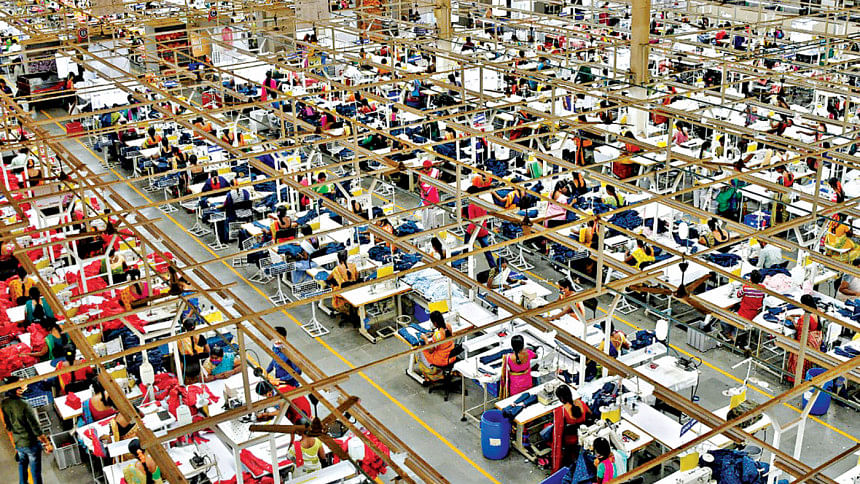
There is no denying the fact that Bangladesh’s strong presence in global apparels market is a testament to the country’s success in terms of export-oriented strategy pursued over the years. Success in the export of this particular item provides Bangladesh with a unique advantage. Through export of apparels Bangladesh has been able to prove its competitive presence in a product that at present has a global export market worth almost $600 billion. And together with textiles, the total market size is about $1 trillion. Indeed, trade in textiles-related items (Textile and Textile Articles belonging to HS Codes 50-63 at two-digit level) accounts for about five percent of all global trade. This testifies to the significantly large market size of this specific group of products. It also speaks of Bangladesh’s strength and good fortune that it has been able to have a strong foothold in a market of this formidable size and diversity. While many developing countries do have a more diversified export base compared to Bangladesh, the combined global market size of several of those products would possibly be only a fraction of the global apparels/textile market. Also, compared to many other commodities, demand for apparels is relatively less volatile. All these combines to enable Bangladesh to potentially gain from deeper intra-apparels product diversification.
As was noted above, the point here is not to argue that Bangladesh does not need to vigorously pursue the goal of export diversification, but to stress that the country should do everything to realise the potentials that the global market for apparels items offer, beyond what has been achieved till now. It is to the credit of Bangladesh’s policymakers, entrepreneurs and workers that the country has been able to translate its comparative advantages into competitive advantage in a product that commands such a significant and widespread global demand. It is building on this solid foundation that Bangladesh should explore and exploit the additional export opportunities in global apparels market through intra-RMG diversification. This should be seen as the next major frontier for expanding Bangladesh’s global export.
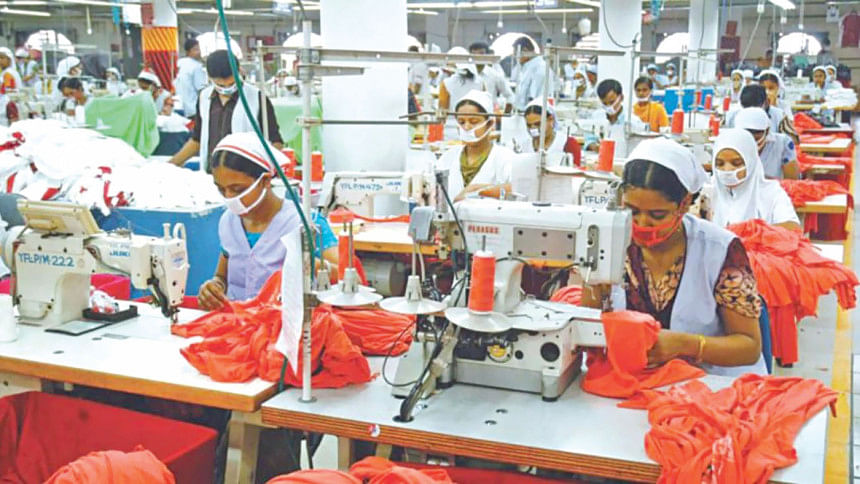
In view of Bangladesh’s export performance in the RMG sector, it is to be noted that even at 6-digit harmonised (disaggregated) level Bangladesh’s apparels exports are at present highly concentrated: only five items constitute more than half of Bangladesh’s total export earnings from apparels. To compare, there are in total 218 items belonging to the apparels category at the 6-digit level. Out of the aforesaid top five items, four were made of cotton; only one item belonged to the non-cotton (man-made fibre) category.
As may be recalled, Bangladesh currently accounts for about 7.9 percent of global apparels export market (2022). Lion’s share of this market belongs to China (31.7 percent); as a group, the EU occupies the second place (27.1 percent). On a welcome note, in recent past years, Bangladesh has been able to make some inroads into the upmarket segment of the global apparels market. In addition to the traditional market segment commanded by Walmart, K-mart, Primark and H&M, Bangladesh’s apparels items are entering the upmarket segment controlled by GAP, ZARA and others. As China gradually shifts from the global apparels markets (lower and middle-end), Bangladesh has an opportunity to occupy a larger share of the vacated territory. Thus, there is a lot of space for Bangladesh to manoeuvre in the global apparels market. But what is being argued here is that it is in the non-cotton segment of the apparels market where the potentials for export expansion are the highest.
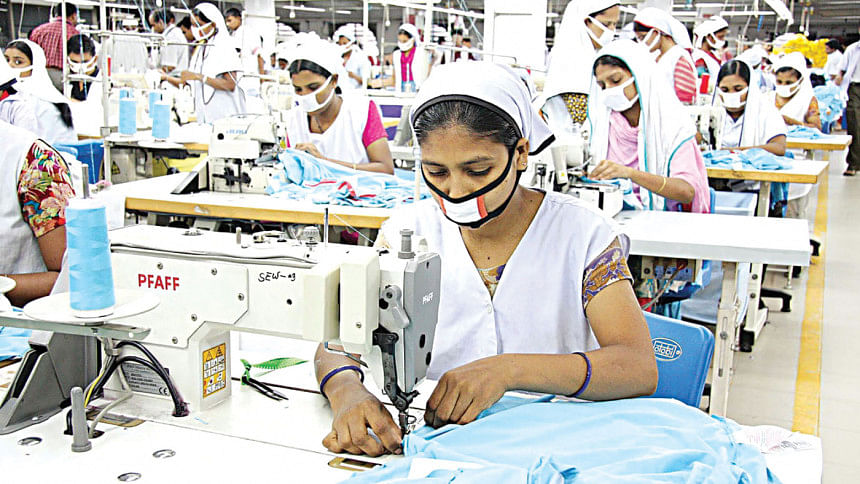
A WINDOW OF OPPORTUNITY
Bangladesh’s apparels exports have traditionally been concentrated at the lower end of the demand curve. That Bangladesh has been able to triple its global market share in apparels, between 2001 and 2021, owes much to its strong showing in export of basic items in cotton-based apparels. However, in moving forward, exporters will need to go for greater diversification within the apparels market to take advantage of the emerging opportunities.
A number of countries is at present vying for being considered as the source-country in view of the China Plus One Strategy being pursued by many brands and buyers. And it is here that non-cotton apparels offer an opportunity to Bangladesh. To note, in traditional market segments Bangladesh is facing unrelenting competitive pressure from several countries such as Vietnam, Myanmar, Cambodia, Turkey and some of the African and Latin American Countries. Research carried out at the Centre for Policy Dialogue (CPD) clearly indicates that export growth is becoming increasingly more driven by volume rather than price, indicating the pressure the country’s entrepreneurs are facing. Also, in the buyer-driven value chain (BDVC) that dominates the apparels market, lower-end exporters are by and large at the mercy of the bulk-buyers and major brands. It is where high value, non-mass produced, fast-fashion non-cotton items have a better prospect and hold promise.
The above is not to say that composition of Bangladesh’s apparels exports has remained the same over the years. If in the early years Bangladesh’s apparels export earnings were primarily driven by woven-items, beginning from early 2000s knitwear exports have started to post higher pace of growth compared to the wovenwear. Consequently, the share of knitwear exports in overall RMG exports began to register a secular rise. From this vantage point, the year FY2007-8 was a turning point and a major milestone when for the first-time earnings from the knitwear items exceeded those of wovenwear (i.e., crossed the 50 percent threshold of earnings from apparel exports). With some exceptions, knitwear export was able to sustain this record for many years since, including over the course of the past three fiscal years.
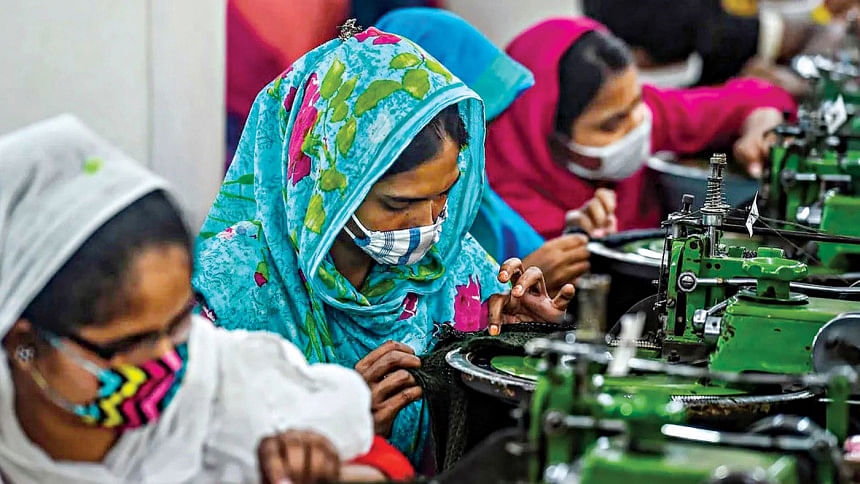
One formidable challenge, which is also an emerging opportunity from the perspective of intra-RMG diversification, concerns Bangladesh’s ability to enter the non-cotton segment of the global apparels market from a position of strength. Bangladesh’s apparels exports have traditionally been concentrated in cotton-made items. Of the top five apparels items of export, only one belonged to non- cotton (MMF) category (at 6-digit level). Over the past decade or so, there has been some positive changes in this regard, in the particular case of woven-RMG exports. The share of non-cotton items in wovenwear (manmade fibre and synthetic fibre-based items and others) has increased from 26.9 percent of the country’s total earnings from wovenwear export to 39.4 percent (between FY2015 and FY2023). However, in case of knitwear the scenario has not undergone any discernible change: the share of non-cotton items remained more or less the same over the corresponding period, at about 24 percent. Indeed, earnings from cotton-based exports accounted for about 70 percent of Bangladesh’s total apparel exports (in FY2023). To compare and contrast, in terms of global imports, cotton-based apparels accounted for only about 40 percent of the global apparel market, the rest 60 percent being the share of non-cotton items. Over the recent years, a clear trend of shifting away from cotton-based apparels items to MMF and synthetic fabrics-based items is becoming increasingly visible in the global market. Bangladesh should seize this emergent opportunity. Bangladesh must now do the needful to ensure greater market share in the growing non-cotton based global apparels market.
In taking advantage of the potential market openings in the non-cotton segment, Bangladesh has a number of advantages to begin with. The country is already a major player in the apparels market, with a proven track record. Buyers and brands know the country as a reliable source and a competitive player, with substantial capacity for mass production. The country’s entrepreneurs have strong networks with key global brands and buyers, have a long history of navigating the sourcing and marketing terrain, understand the complexities of this business and are adept in the crafts and tools of marketing. Accordingly,
the sector has already gained a degree of maturity to aim for the next frontier.
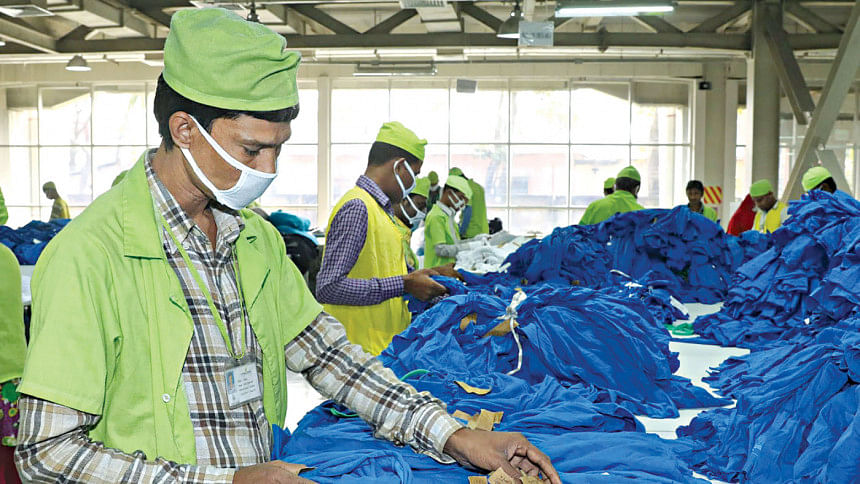
TASKS AHEAD
What is now needed is to be able to move into the non-cotton segment of the apparels market in a strategic manner. Both appropriate policies and concrete actions will be called for to realise the emergent opportunities. As is known, production of MMF and synthetic based items tends to be relatively more capital-intensive and is primarily technology-driven. However, technological embeddedness of Bangladesh’s exports has tended to remain rather low till now. While competitors such as Vietnam have been able to make notable transition to medium and higher technology-embedded exports, Bangladesh’s situation in this regard has remained unchanged; rather, the scenario has worsened.
The duties on import of capital machineries are already low in Bangladesh. Entrepreneurs enjoy bonded warehouse facilities to import raw materials and intermediates. Technology adoption and upgradation will need to be incentivised and encouraged. Entrepreneurs will need to have access to credit on reasonable terms; a special investment fund may be created towards this. Special training centres for workers, mid-level management, quality controllers, fashion and design professionals will need to be set up for production of upmarket MMF and synthetic apparels products. The incentive structure enjoyed by the RMG sector should be revisited and restructured to encourage entrepreneurs willing to go for intra-RMG diversification. Support will need to be put in place for establishment of strong backward linkages in non-cotton apparels sector.
Emphasis will need to be put on production of higher value-added products—men’s and women’s blazers, suits, water-proof garments, leather jackets, slow moving high-end fashion and design products. Bonded warehouse facilities and customs procedures for imports of machineries, raw materials and intermediates will need to be further simplified, and logistics and trade facilitation measures will need to be more investment-friendly and trade-supportive.
To recall, only 12 percent of Bangladesh’s exports are destined for the markets of South Asia, East Asia and ASEAN combined. Export of non-cotton items will need to be targeted at the markets of countries in the neighbouring regions which import significant amount of apparel items. Product diversification and market diversification should go in tandem. Strengthened forward linkages and greater presence of the Bangladesh brand abroad will be crucial. This is where foreign direct investment, particularly in the special economic zones, targeting traditional and non-traditional markets, could play a crucially important role. FDIs should also be welcomed because of their close connection with foreign buyers and familiarity with market trends, patterns and demands.
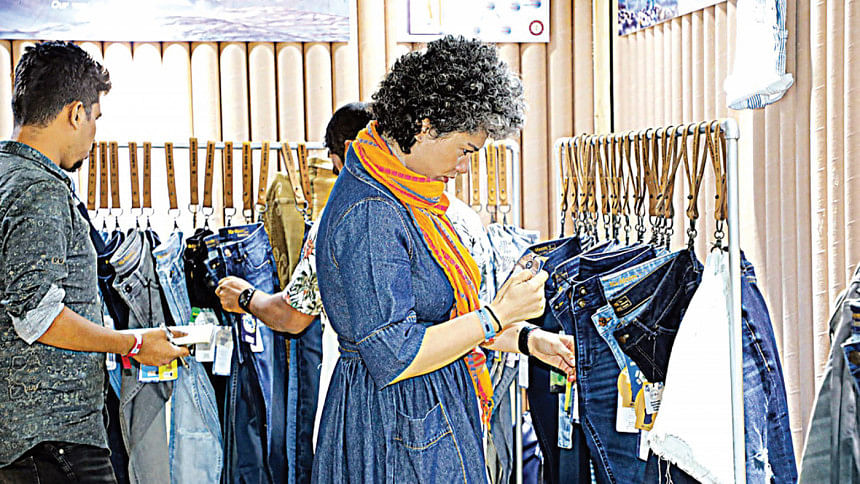
Bangladesh is at present preparing for its post-LDC future. Indeed, the country stands at a crossroads in this backdrop. A large part of the preferential market access will no longer be available to Bangladesh’s apparels exporters on graduation from the group of the LDCs (in November 2026). While the EU and the UK have extended the preferential market access treatment by three years for the graduating LDCs, the scenario of trading in apparels is going to change significantly for Bangladesh over the foreseeable future. To enjoy GSP Plus in the EU (the proposed single market import ceiling will need to be raised though) and the enhanced preference in the UK (new rules of origin will require double transformation in spinning and weaving), and backward and forward linkages of apparels industry will need to be significantly strengthened. Incentives for the apparels sector will need to be recalibrated to stimulate technology upgradation and skills development.
In view of its LDC graduation, Bangladesh will also need to comply with the different obligations under the various WTO agreements which are applicable for (non-LDC) developing country members of the WTO. These relate to amount of subsidy, type of support extended to the export sector, trade facilitation measures, notification requirements and other regulations and rules.
There are many regulatory measures which will need to be complied with as Bangladesh pursues intra-RMG diversification strategy. Also, compliance requirements of key destination countries and brands and buyers in areas of labour rights, environmental standards, carbon emission, gender rights, governance and management of production processes are becoming increasingly stringent. An energetic move towards intra-RMG diversification will call for upfront attention to all these newly emerging demands originating from both the multilateral trading regime, requirements of key destination countries and those of brands and buyers in areas of compliance.
CONCLUDING REMARKS
Building on their impressive track record, Bangladesh’s entrepreneurs are well- positioned to realise the potential opportunities in the increasingly growing non-cotton segment of the global apparels market. Some inroads are already being made. A number of entrepreneurs have ventured into this segment of production. However, till now, the realised investment has been far below the potential.
Having made the first transition, from the predominantly wovenwear driven to knit and wovenwear driven composition of exports, Bangladesh will now need to make the second transition, from the predominantly cotton-based exports to the twin drivers of cotton and non-cotton-based exports. Bangladesh has all the reasons to make this second transition happen. It has accomplished such a feat in the past. However, the country will need to address the emergent second generation of challenges successfully to repeat such a feat over the near- to medium-term future.



